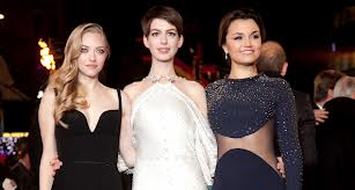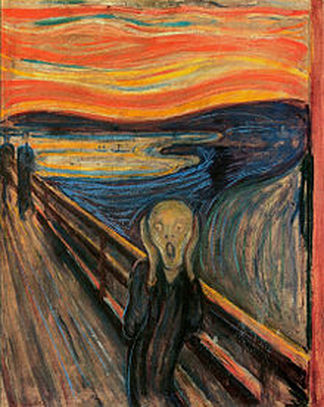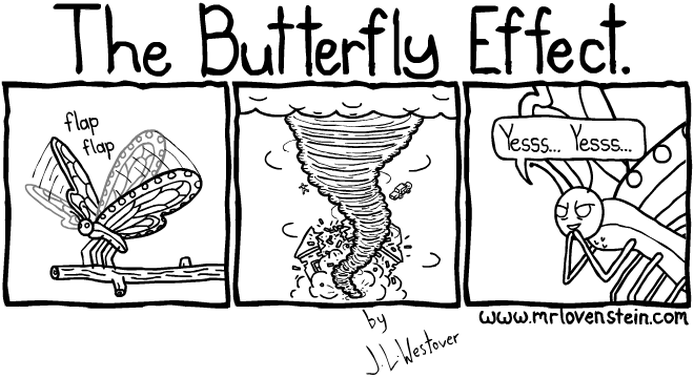
The Cast of Les Mis.
Cesia and I decided to show Les Misérables for our movie presentation. The movie entails the story of Jean Valjean, a prisoner of the French Revolution trying to reach a better place for himself. After serving his time in prison for stealing a loaf of bread to feed his sister's son, Valjean has to face society's contempt towards "Criminals." No one is willing to hire nor help him until he runs into a Priest who welcomes him with open arms. The Priest sparks the turning point in Valjean's life where he decides to forgive himself for his past and start a new life. Valjean was no longer. His new name was Mr. Lameur, mayor of his city.
The story contains lots of characters that are opposite of each other but emphasize a certain situation that everyone can relate to. The most tragic character is Fantine, a mother who has to sacrifices herself for her daughter's well being. Stressed and worried about her financial situation, she eradicates all the things that make up the identity and confidence of a woman. She sells her hair; a symbol of pride and beauty; and her body, which represent the holy temple of your soul lies. Her sacrifices were not vain. Cosette, the daughter of Fantine, is adopted by the wealthy and renewed Valjean. Cosette grows up only to fall in love with the dashing Marius, a revolutionary leader fighting for equality. While being raised by horrible foster parents, Cosette grew up with a girl named Eponine, who adds an emotional level to the movie as she showacases what its felt to be in love with someone you doesn't love you back. I am very impressed and applaud Victor Hugo for creating this eternal story.
P.S Check out Lea Salonga, broadway actress of Eponine, sing On My Own. She is also the voice of Disney's Princess Jasmine and Princess Mulan.
Jose.
Mental illness is a social taboo. Yea, we all joke around like when we say someone is "crazy" but do we really know what that means? In my life, I have never met anyone with a mental condition or illness and I'm glad the movie One Flew Over The Cuckoo's Nest brought this to my attention. As a growing enthusiast, I realized how important this experience is to my life. Directed by Milos Forman and based on the 1962 novel by Ken Kesey, the movie exposes the life of a man named Randle Patrick McMurphy and his experience at a mental hospital. Randle is a middle aged man who sees life from a different perspective than what other believe is "normal". Running away from trouble and jail, Randle sometimes faked having a mental illness and usually this was his way of confronting the consequences of his actions until he got reffered to a hospital. There he met many patients, all voluntary, and Randel's positively outgoing, yet raffish, acts brought a lot of confidence to them, notably in the character named Chief. I was really touched by the different point of view. Who would ever think to make a movie about what happens in a mental hospital? The main belief I had of them was the one portrayed by modern horror and suspense movie, the one that causes fear but that notion is completely shattered now. My fear was ignorance and after watching this movie I am no longer ignoring the fact that mental patients are not different from the rest of us. They, too, crave freedom, love, affection, tranquility and self actualization! My favorite part? The way Kesey chose to transmit this story. Very impressive and truly life changing. McMurphy will now stay in mind and will take me one step closer to becoming a human with a broad level of understanding and tolerance. One Flew Over The Cuckoo's Nest is a legend and like all legends, they are never normal and always defy society.
Jose.

Expressionism is a modernist movement that started in poetry and painting. I was so excited to learn about this movement. Expressionism originated in Germany at the beginning of the 20th Century. As you can see from the painting to the left, Expressionism deals with expressing yourself through distorting reality according to emotions to create a unique perspective that will send a desired mood or message. Can you guess what is the mood received from this picture? I get the sense that Edvard Munch wanted to show how a person can feel over whelmed that a physical activity must be incorporated to unleash the tensions. Analyzing this painting according to the definition, I find it to be a perfect example. All of the colors used evoke the same feeling. The unleashing of emotions should be expressed with fiery reds and shades of oranges. The shades of blues and grays also show the darkness of emotions.
The main goal of Expressionist artists was to express what it is felt inside instead of the reality of the outside. What is unique about expressionism is the fact that what is felt inside could very well be abstract. It is not bound by the rules of sense and laws. It completely unchains your talents and allows you to be as crazy and over the top as possible. Painters like El Greco, who was reference in many literary works like The Great Gatsby, is considered an Expressionist along with Mexican painter Mathias Goeritz.
Expressionism was so influential in the arts that the movement expanded to other subjects like Literature, Dance, and Cinema. Everyone was on board with this movement. I thought about the short stories that I've read in class that could be analyzed with this idea exposed by expressionism. I think that Miss Brill by Katherine Mansfield, A Worn Path by Eudora Welty are both example of expressionistic literary works. In both stories, reality is altered to successfully transmit the emotion of the main characters which could be how the author feels about a certain topic. Katherine Mansfield could feel a certain sympathy towards the elderly that are slowly excluded from society and Eudora Welty passionate about the emotions felt by determined human beings so they decided to alter reality through their stories by using a stream of consciousness point of view. It's really a deep topic that could be talked about for hours. Let's just remember that expressionism is about expressing the inside meaning and emotions one feel instead of the reality. No one likes a normal piece of art.
Can you think of any works that could reflect aspects of Expressionism?
Check out this online documentary on Expressionism.
Jose.

Don't you think the comic strip above describes The Butterfly Effect beautifully? The Butterfly Effect is a well known concept. It states that even the flapping of a butterfly's wing can change the weather in another part of the world. What a lot of people don't realize is this is meant to be understood as a metaphor to the power the small things have. They can change greatly a situation. A good personal example is when students take a test. The difference between an F and an A+ could be if you grab that bagel that morning or even if you set your alarm clock the night before! Its kind of scary thing to think about. The smallest thing could decide whether something tragic or magical happens. The reason why the tiniest change has a large effect on nature is because nature is constantly balancing. If one thing changes, such as the particles pushed by the wind off of the flapping of a butterfly's wing, will cause the system to rebalance and as The Chaos Theory states, the system could either reach a never even Strange Attractor or a normal Attractor. The Butterfly Effect and The Chaos Theory are intertwined with each other.
Jose.
"The most beautiful thing we can experience is the mysterious.
It is the source of all true art and science."
- Albert Einstein
The mysteries of life are heady to humans. We crave to solve them. We crave to know their origin. We crave to understand them. I like to think that scientists have a list of puzzles they see as a challenge to resolve and right at the top, there 's the most unsolvable. Nature is just one that will never be completely understood. It's unpredictable and because we are not allowed to understand is the exact same reason why we want it.
Edward Norton Lorenz, an American mathematician and meteorologist, was fascinated in figuring out if the weather could be predicted. He started to play around with a computer program in which created replications of weather to a certain formula that you would input. The program would give certain outputs of numbers in a certain sequence and he copied the middle of one run and inserted into the computer. Instead of starting from the beginning, the assimilation would start from the middle of a run. He thought this change wouldn't affect anything and expected the same weather from the run starting at the beginning but found the weather was totally different than before!
Now,
The Chaos Theory is what attempts to explain this. The Chaos Theory is a mathematical sub-discipline that studies complex systems. A
complex system is defined as systems that contain so many motion or factors that make its behavior impossible to predict because there are so many things to take into account. Weather is a complex system and part of the reason why weather predictions are often wrong is because there are so many factors that influence the weather and change it every second. Regardless of the many factors affecting a complex system, Lorenz found that complex system all seem to seek an equilibrium of some sort called an
attractor. Even though complex systems are unpredictable, he believes there is a way to make a approximation of the unknown.
As a summary, the main key points
of The Chaos Theory are: - A tiny difference in initial parameters ( conditions ) will result in a completely different behavior of a complez system.
- Complex systems seek an specific situation or equilibrium that can be either static ( Attractor ) or dynamic ( Strange Attractor ).
- The Uncertainty Principal prohibits accuracy.
The smallest change can have a large effect. Hm... I wonder where have I heard that before? Oh I know. Remember those science fiction movies that taught you that if you ever were to travel back in time you should not change anything because that will change the present? Yea... Makes me wonder how many works I've read without even realizing this theory was applied.
Jose.





 RSS Feed
RSS Feed